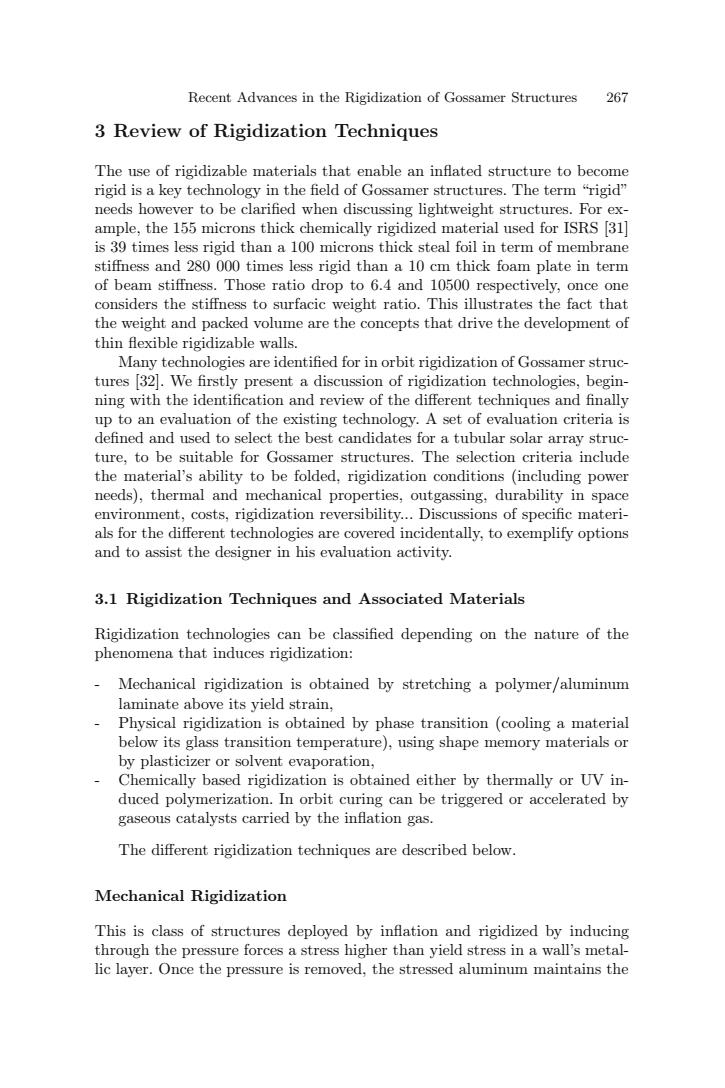正在加载图片...

Recent Advances in the Rigidization of Gossamer Structures 267 3 Review of Rigidization Techniques The use of rigidizable materials that enable an inflated structure to become rigid is a key technology in the field of Gossamer structures.The term"rigid" needs however to be clarified when discussing lightweight structures.For ex- ample,the 155 microns thick chemically rigidized material used for ISRS 31] is 39 times less rigid than a 100 microns thick steal foil in term of membrane stiffness and 280 000 times less rigid than a 10 cm thick foam plate in term of beam stiffness.Those ratio drop to 6.4 and 10500 respectively,once one considers the stiffness to surfacic weight ratio.This illustrates the fact that the weight and packed volume are the concepts that drive the development of thin flexible rigidizable walls. Many technologies are identified for in orbit rigidization of Gossamer struc- tures [32.We firstly present a discussion of rigidization technologies,begin- ning with the identification and review of the different techniques and finally up to an evaluation of the existing technology.A set of evaluation criteria is defined and used to select the best candidates for a tubular solar array struc- ture,to be suitable for Gossamer structures.The selection criteria include the material's ability to be folded,rigidization conditions (including power needs),thermal and mechanical properties,outgassing,durability in space environment,costs,rigidization reversibility...Discussions of specific materi- als for the different technologies are covered incidentally,to exemplify options and to assist the designer in his evaluation activity. 3.1 Rigidization Techniques and Associated Materials Rigidization technologies can be classified depending on the nature of the phenomena that induces rigidization: Mechanical rigidization is obtained by stretching a polymer/aluminum laminate above its yield strain, Physical rigidization is obtained by phase transition (cooling a material below its glass transition temperature),using shape memory materials or by plasticizer or solvent evaporation, Chemically based rigidization is obtained either by thermally or UV in- duced polymerization.In orbit curing can be triggered or accelerated by gaseous catalysts carried by the inflation gas. The different rigidization techniques are described below. Mechanical Rigidization This is class of structures deployed by inflation and rigidized by inducing through the pressure forces a stress higher than yield stress in a wall's metal- lic layer.Once the pressure is removed,the stressed aluminum maintains theRecent Advances in the Rigidization of Gossamer Structures 267 3 Review of Rigidization Techniques The use of rigidizable materials that enable an inflated structure to become rigid is a key technology in the field of Gossamer structures. The term “rigid” needs however to be clarified when discussing lightweight structures. For example, the 155 microns thick chemically rigidized material used for ISRS [31] is 39 times less rigid than a 100 microns thick steal foil in term of membrane stiffness and 280 000 times less rigid than a 10 cm thick foam plate in term of beam stiffness. Those ratio drop to 6.4 and 10500 respectively, once one considers the stiffness to surfacic weight ratio. This illustrates the fact that the weight and packed volume are the concepts that drive the development of thin flexible rigidizable walls. Many technologies are identified for in orbit rigidization of Gossamer structures [32]. We firstly present a discussion of rigidization technologies, beginning with the identification and review of the different techniques and finally up to an evaluation of the existing technology. A set of evaluation criteria is defined and used to select the best candidates for a tubular solar array structure, to be suitable for Gossamer structures. The selection criteria include the material’s ability to be folded, rigidization conditions (including power needs), thermal and mechanical properties, outgassing, durability in space environment, costs, rigidization reversibility... Discussions of specific materials for the different technologies are covered incidentally, to exemplify options and to assist the designer in his evaluation activity. 3.1 Rigidization Techniques and Associated Materials Rigidization technologies can be classified depending on the nature of the phenomena that induces rigidization: - Mechanical rigidization is obtained by stretching a polymer/aluminum laminate above its yield strain, - Physical rigidization is obtained by phase transition (cooling a material below its glass transition temperature), using shape memory materials or by plasticizer or solvent evaporation, - Chemically based rigidization is obtained either by thermally or UV induced polymerization. In orbit curing can be triggered or accelerated by gaseous catalysts carried by the inflation gas. The different rigidization techniques are described below. Mechanical Rigidization This is class of structures deployed by inflation and rigidized by inducing through the pressure forces a stress higher than yield stress in a wall’s metallic layer. Once the pressure is removed, the stressed aluminum maintains the